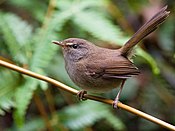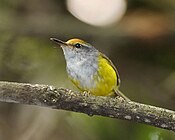Cettiidae
| Cettiidae | |
|---|---|

| |
| Cetti's warbler, Cettia cetti | |
| Scientific classification | |
| Domain: | Eukaryota |
| Kingdom: | Animalia |
| Phylum: | Chordata |
| Class: | Aves |
| Order: | Passeriformes |
| Superfamily: | Sylvioidea |
| Family: | Cettiidae Alström, Ericson, Olsson, & Sundberg, 2006 |
| Genera | |
|
Abroscopus | |
Cettiidae is a newly validated family of small insectivorous songbirds ("warblers"), formerly placed in the Old World warbler "wastebin" assemblage. It contains the typical bush warblers (Cettia) and their relatives. As a common name, cettiid warblers is usually used.[1]
Some taxonomic authorities include this entire family, as D. Winkler et al. in an enlarged family Scotocercidae.[2]
Its members occur mainly in Asia and Africa, ranging into Oceania and Europe. The pseudo-tailorbirds, tesias and stubtails, as well as Tickellia and Abroscopus warblers are mostly found in the forests of south and southeastern Asia, with one species reaching as far north as Japan and Siberia. The genus Cettia has the widest distribution of the family, reaching from Western Europe across Asia to the Pacific islands of Fiji and Palau. Most of the species in the genus are sedentary, but the Asian stubtail is wholly migratory and the Japanese bush warbler and Cetti's warbler are partly migratory over much of their range. A few species, such as the pale-footed bush warbler, are altitudinal migrants.
The species are small, stubby birds. Most have moderately long to long tails, while the stubtails and tesias have tiny tails that do not even emerge past their tail rectrices. The group is typically clad in dull plumage, often with a line above the eye. Altogether the Cettiidae are a quite variable group containing many aberrant birds that hitherto had been uncomfortably placed with a wide range of unrelated families. The Megaluridae which contain birds which appear very similar to many cettiids are far more uniform by contrast.[3]
Most live in scrubland and frequently hunt food by clambering through thick tangled growth.
Among the "warbler and babbler" superfamily Sylvioidea, the Cettiidae represent an ancient lineage. As a group, they are probably closest to the Aegithalidae, the long-tailed tits and relatives.[1]
Genera
There are 32 species in seven genera.
| Image | Genus | Living species |
|---|---|---|
 |
Abroscopus Baker, 1930 - warblers |
|
 |
Urosphena R. Swinhoe, 1877 – stubtails |
|
 |
Tesia Hodgson, 1837 – tesias |
|
 |
Horornis Hodgson, 1845 |
|
 |
Cettia Bonaparte, 1834 – typical bush warblers |
|
 |
Tickellia Blyth, 1861 – broad-billed warbler |
|
 |
Phyllergates Sharpe, 1883 |
|
Footnotes
References
- Alström, P.; Ericson, P.G.P.; Olsson, U. & Sundberg, P. (2006): Phylogeny and classification of the avian superfamily Sylvioidea. Mol. Phylogenet. Evol. 38(2): 381–397. doi:10.1016/j.ympev.2005.05.015 PMID 16054402 PDF fulltext
- del Hoyo, Josep; Elliott, Andrew & Sargatal, Jordi (eds.) (2006): Handbook of Birds of the World (Volume 11: Old World Flycatchers to Old World Warblers). Lynx Edicions, Barcelona. ISBN 84-96553-06-X
- Sefc, K.M.; Payne, R.B. & Sorenson, M.D. (2003): Phylogenetic relationships of African sunbird-like warblers: Moho Hypergerus atriceps, Green Hylia Hylia prasina and Tit-hylia Pholidornis rushiae. Ostrich 74(1-2): 8-17. PDF fulltext
